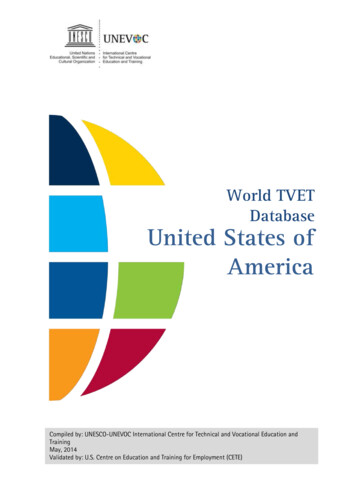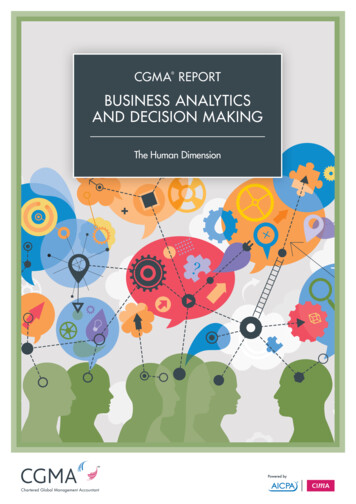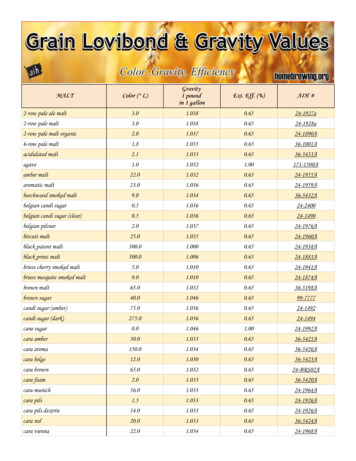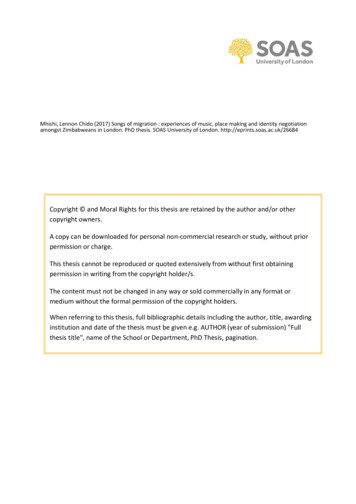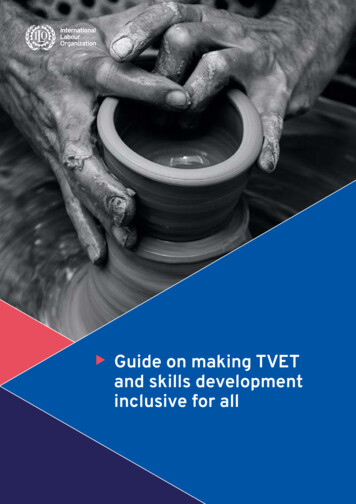
Transcription
Guide on making TVETand skills developmentinclusive for all
Guide on making TVETand skills developmentinclusive for allRalf LangeChristine HofmannManuela Di CaraMarch 2020ILO Skills and Employability Branch
Copyright International Labour Organization 2020First published (2020)Publications of the International Labour Office enjoy copyright under Protocol 2 of the Universal CopyrightConvention. Nevertheless, short excerpts from them may be reproduced without authorization, oncondition that the source is indicated. For rights of reproduction or translation, application shouldbe made to ILO Publications (Rights and Licensing), International Labour Office, CH-1211 Geneva 22,Switzerland, or by email: rights@ilo.org. The International Labour Office welcomes such applications.Libraries, institutions and other users registered with a reproduction rights organization may makecopies in accordance with the licenses issued to them for this purpose. Visit www.ifrro.org to find thereproduction rights organization in your country.Guide on making TVET and skills development inclusive for allISBN: 978-92-2-134056-0 (print)978-92-2-134057-7 (web pdf)The designations employed in ILO publications, which are in conformity with United Nations practice,and the presentation of material therein do not imply the expression of any opinion whatsoever on thepart of the International Labour Office concerning the legal status of any country, area or territory orof its authorities, or concerning the delimitation of its frontiers.The responsibility for opinions expressed in signed articles, studies and other contributions rests solelywith their authors, and publication does not constitute an endorsement by the International LabourOffice of the opinions expressed in them.Reference to names of firms and commercial products and processes does not imply their endorsementby the International Labour Office, and any failure to mention a particular firm, commercial product orprocess is not a sign of disapproval.Information on ILO publications and digital products can be found at: www.ilo.org/publns.Cover photo credits: Quino Al on UnsplashDesign by the International Training Centre of the ILO, Turin – Italy
Guide on making TVET and skills development inclusive for allForewordTVET closures and the economic impacts ofOnly few national TVET policies and strategiesthe COVID-19 pandemic risk exacerbatingrefer to inclusion, primarily focusing oninequalities and causing a “lockdowngeneration”. Inclusive skills developmentand lifelong learning opportunities are vitalto prevent people from being left behind,to maintain people’s employability, and toensure that economies and enterprises recoverpromptly from the crisis.In principle, skills development systemscater to all people striving to learn relevantskills to earn a living and find their placein society. In reality, many individuals andgroups in society find themselves excludedfrom learning opportunities, for a wide rangeof reasons. People in precarious, informalemployment face numerous access barriers,and availability and accessibility of trainingcentres might pose a problem for people livingin remote areas or people with disabilities.Perceptions and stereotypes can influence theselection of training courses, discouraginginterested persons from joining certaincourses. Training environments might notbe amenable to all people, causing higherdrop-out rates if learning methodologies donot take account of special needs of learnersor for women, if separate washrooms orlighting are not installed. After graduation,transition to employment can also be morechallenging if labour market actors perpetuatediscrimination. Ensuring that disadvantagedgroups enjoy inclusive skills developmentenvironments will help them be moresuccessful in transitioning to decent work.gender equality. Awareness building of policymakers is critical to expand TVET policies to allexcluded individuals or groups and to movetowards greater inclusion in skills developmentand lifelong learning for all.This ILO guide on making TVET and skillsdevelopment inclusive for all targets policymakers and representatives of workers’ andemployers’ organizations engaged in skillsdevelopment systems, TVET centre staff, anddevelopment practitioners providing skills policyadvice. The guide aims to help skills decisionmakers and practitioners assess to what extenttheir TVET system is currently excluding certainindividuals or groups, identifies underlyingreasons, and provides practical ideas on whatcould be done to redress inequalities. Theguide’s self-assessment tool is also available indigital format.Improving the labour market prospects andquality of work for those disadvantaged inthe labour market is a key focus of the ILO’sresearch and capacity building agenda.Inclusion is not just a normative goal, it alsobenefits employers who gain a broader poolof available skills, co-workers who learn frommore diverse environments, and governmentsand societies who would otherwise shoulderthe costs of exclusion.This guide has been authored by Ralf Lange,Christine Hofmann and Manuela Di Cara.It incorporates comments from JürgenMenze, Gurchaten Sandhu, Laura Schmid,iii
ivGuide on making TVET and skills development inclusive for allChapter title to go hereMaaret Canedo Lohikoski, Maria TeresaGutierrez, Ashwani Aggarwal, and Rafael Peels.The self-assessment tool was piloted during anITC/ILO E-learning course on Skills for SocialInclusion. Janet Neubecker and the ITC-ILODelta team supported in editing, formatting,layout and publishing.The SKILL-UP project funded by theGovernment of Norway, and the Partnershipfor improving prospects for forcibly displacedpersons and host communities (PROSPECTS)funded by the Government of the Netherlandscontributed financially to the guide and thedigital interactive tool.We hope that this guide provides thenecessary rationale and tools to accelerateaction on inclusion in TVET and skillsdevelopment and helps boost recovery fromthe COVID-19 pandemic for those who needit most.Srinivas ReddyChiefILO Skills and Employability Branch
Guide on making TVET and skills development inclusive for allTable of contentsForeword. iiiList of Abbreviations. viiHow to use this guide?. ixChapter 1Setting the scene .11.1Facts and trends of inclusion in TVET. 21.2Key concepts: What is inclusion?. 71.3The benefits of social inclusion in TVET. 11Chapter 2Assessing who is excluded and why. 152.1Excluded groups and individuals – the state of play. 162.2Assessing where, when and how exclusion happens in TVET. 262.3Framework for analysis of inequalities in TVET. 35Chapter 3Redressing inequalities and making TVET inclusive for all. 393.1Devising inclusive TVET policies and strategies. 413.2Universal TVET system design. 423.3Targeted measures. 56Chapter 4Specific themes and issues addressed in case studies. 614.1TVET Reform Project in Bangladesh. 624.2Gender mainstreaming in training institutions in Central America. 654.3Recognition of Prior Learning (RPL) for Syrian refugees in Jordan. 684.4Training for Rural Economic Empowerment (TREE). 714.5Creating space for addressing homophobia in TVETcolleges in South Africa. 74v
viGuide on making TVET and skills development inclusive for all4.6Upgrading the informal apprenticeship system in Benin. 774.7TVET e-tools and e-learning: Indigenous people in Australia. 804.8Social inclusion, employability training and HIV/AIDS in East andSouthern Africa. 824.9Learning by doing: Training self-employed workers outside offormal TVET in Mexico. 84References. 87List of TablesTable 1.Self-assessment checklist: Excluded groups and individuals. 16Table 2.Self-assessment checklist: Accessibility, selection, enrolment andchoice of training. 27Table 3.Self-assessment checklist: Attendance, drop-outs, learning materials andteaching processes. 30Table 4.Self-assessment checklist: Assessment, certification and transitionto work. 34Table 5.Proposed topics, methods and indicators for analysis of inequalitiesin TVET. 36Table 6.Self-assessment checklist: Inclusive policies and systems. 40List of FiguresFigure 1. Inclusive TVET – Where exclusion might happen. 26Figure 2. Policy dimensions. 41Figure 3. Building blocks of inclusive TVET systems. 43
Guide on making TVET and skills development inclusive for allList of AbbreviationsCAQAJordanian Centre for Accreditation Quality AssuranceCBT&ACompetency-based training and assessmentCCGCorporate community groupCEDEFOPEuropean Centre for the Development of Vocational TrainingCEEPCorridor Economic Empowerment ProjectCQMCertification of qualification for tradesCRPCentre for Rehabilitation of the Paralyzed, BangladeshECOSOCUnited Nations Economic and Social CouncilEUEuropean UnionHIV/AIDSHuman immunodeficiency virus and acquired immune deficiency syndromeHRDHuman resources developmentICTInformation and communication technologyILO/CINTERFORInter-American Centre for Knowledge Development in Vocational TrainingINAInstituto Nacional de Aprendizaje, Costa RicaLGBTILesbian, gay, bisexual, transgender and intersex peopleNEETNot in employment, education or trainingNORRAGNetwork for International Policies and Cooperation in Education and TrainingRPLRecognition of prior learningSTEMScience, technology, engineering and mathematicsSWTSchool-to-work transitionToTTraining of trainersTREETraining for rural economic empowermentTVETTechnical and vocational education and trainingUNDESAUnited Nations Department of Economic and Social AffairsUNESCOUnited Nations Educational, Scientific and Cultural OrganizationUNEVOCInternational Centre for Technical and Vocational Education and TrainingUNHCRUnited Nations High Commissioner for RefugeesUNHRCUnited Nations High Commissioner for Human RightsWIEGOWomen in Informal Employment: Globalizing and Organizingvii
ixGuide on making TVET and skills development inclusive for allHow to use this guide?How to use this guide?Why this guide? Inclusion in TVET and skillsdevelopment is in everyone’s interest – andyet, it is not happening enough. This guideprovides arguments for inclusion, helps assessto what extent the current system is inclusive orexclusive, why, and what could be done to redressinequalities. It provides a tool that takes a broadperspective on inclusion, and complements othertools designed for specific groups or individuals invulnerable situations.Self-assessment: The guide includes several selfassessment tools to initiate reflection and learning.This can inform self-evaluation and strategicplanning processes. The self-assessments may becompleted by an individual or by a selected groupof people. Alternatively, the assessment questionscan also guide a peer-learning process amongtrainees.Questions or statements are embedded in tables,and answers rank between 1 (very little) and 5(very much), or are specified for each question. Theright column provides links to relevant sections inthe guide, or to further information relevant to thequestion. ILO / M. CrozetWho is it for? This guide is aimed at policymakers, representatives of workers’ and employers’organizations engaged in skills developmentsystems, TVET centre managers, and developmentpractitioners providing skills policy advice.
xGuide on making TVET and skills development inclusive for allHow to use this guide?X Example:QuestionResponse1Do you conduct regular studies to trace wXTo wha
courses. Training environments might not be amenable to all people, causing higher drop-out rates if learning methodologies do not take account of special needs of learners or for women, if separate washrooms or lighting are not installed. After graduation, transition to employment can also be more challenging if labour market actors perpetuate discrimination. Ensuring that disadvantaged .
